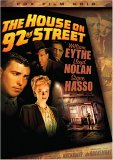| Reviews & Columns |
|
Reviews DVD TV on DVD Blu-ray 4K UHD International DVDs In Theaters Reviews by Studio Video Games Features Collector Series DVDs Easter Egg Database Interviews DVD Talk Radio Feature Articles Columns Anime Talk DVD Savant Horror DVDs The M.O.D. Squad Art House HD Talk Silent DVD
|
DVD Talk Forum |
|
|
| Resources |
|
DVD Price Search Customer Service #'s RCE Info Links |
|
Columns
|
|
|
House on 92nd Street, The
Based on fact, the film follows the FBI's investigation of fifth columnist Germans operating out of New York City in the years before and during the Second World War. Planting double-agent Bill Dietrich (William Eythe) into a German sleeper cell at a house on 92nd Street near Madison Avenue in Upper Manhattan, counterterrorism FBI Agent George A. Briggs (Lloyd Nolan) intercepts secret messages being sent to Hamburg and eventually learns of a plot to steal vital information on "Process 97," the U.S. Government's top secret development of the atomic bomb.
The 88-minute film is breathlessly-paced, engrossing from beginning to end. Producer De Rochemont (later a key figure in the development of Cinerama and Cinemiracle) had created the influential March of Time film series, a kind of proto-60 Minutes. Armed with a script that lionized the agency, De Rochemont was able to secure the cooperation of J. Edgar Hoover and shoot extensively at FBI headquarters and various training facilities and labs, capturing much of its neat-o technology. The opening reel is especially strong, with agents using what was then state-of-the-art equipment to decode messages hidden in postage stamps, between lines of text in hand-written letters, etc.
For 1945 audiences, The House on 92nd Street must have been a revelation. Though FBI stories are a dime a dozen in 2005 movies and on TV, to see this back then, presented with such startling realism for the first time must really have been something, particularly with its A-bomb story coming so soon after the real bombs had been dropped on Hiroshima and Nagasaki, only weeks before (the film went into release less than a month after the Japanese surrender). Further adding to the verisimilitude is the casting; except for Nolan, just three years but a million miles from his popular Michael Shayne character and, to a lesser degree, a few familiar character players like Gene Lockhart and Leo G. Carroll, the cast is comprised of relative unknowns and real-life FBI employees in bit parts.
The film uses actual FBI surveillance footage while other scenes are faked or at least carefully integrated with the real stuff. It's a shame that the Germans speak only English to one another, even in scenes set in Germany. Had those characters actually delivered their lines in German, the illusion would've been complete.
Because of all this, the line between actors delivering lines and real G-Men doing their job is blurred, and the use of real locations (at a time when "New York" usually meant a trip to the studio backlot) adds considerably to the realism and this film's success fueled the wider use of on-location filming. The writing was on the wall; even with the location filming the picture cost just $965,000 yet earned $2.5 million in rentals, a considerable success in 1945 dollars. It was Fox's third-biggest money-earner that year and certainly its most profitable.
A semi-sequel, The Street with No Name, also featuring Nolan, followed three years later.
Video & Audio
The House on 92nd Street is presented in its original full-frame aspect ratio and its original black and white. The transfer is very good, the film elements showing only minimal wear and retaining good contrast. The English mono track is fine; an ill-advised faux stereo track is also offered, along with a monophonic Spanish one. Optional subtitles are available in both English and Spanish.
Extra Features
Extras include an informative Commentary by Film Noir Historian Eddie Muller, who puts the film into context, explains why De Rochemont more than credited director Henry Hathaway is responsible for the film's innovations, and why the film, well, isn't really a noir. Fox Noir includes a batch of related trailers, but there's none for The House on 92nd Street. An Official Press Book does what DVD producers should be doing all along: instead of offering pressbooks, newspaper clippings and the like in unreadable tiny type, viewers have the option to use their DVD remote to "zoom-in" on selected parts of the pressbook to read text or examine advertising in more detail. A nice function. A Photo Gallery is better than most, and includes a few set stills and other production images.
Parting Thoughts
This is a must-see, not just for noir fans but for anyone with a genuine interest in American cinema, for few films were as influential as The House on 92nd Street. Fox's presentation of this title and decent selection of extras, combined with a bargain basement SRP of just $14.98, make this one not to pass up.
Stuart Galbraith IV is a Kyoto-based film historian whose work includes The Emperor and the Wolf - The Lives and Films of Akira Kurosawa and Toshiro Mifune and Taschen's forthcoming Cinema Nippon. Visit Stuart's Cine Blogarama here.
|
| Popular Reviews |
| Sponsored Links |
|
|
| Sponsored Links |
|
|
| Release List | Reviews | Shop | Newsletter | Forum | DVD Giveaways | Blu-Ray | Advertise |
|
Copyright 2024 DVDTalk.com All Rights Reserved. Legal Info, Privacy Policy, Terms of Use,
Manage Preferences,
Your Privacy Choices | |||||||












